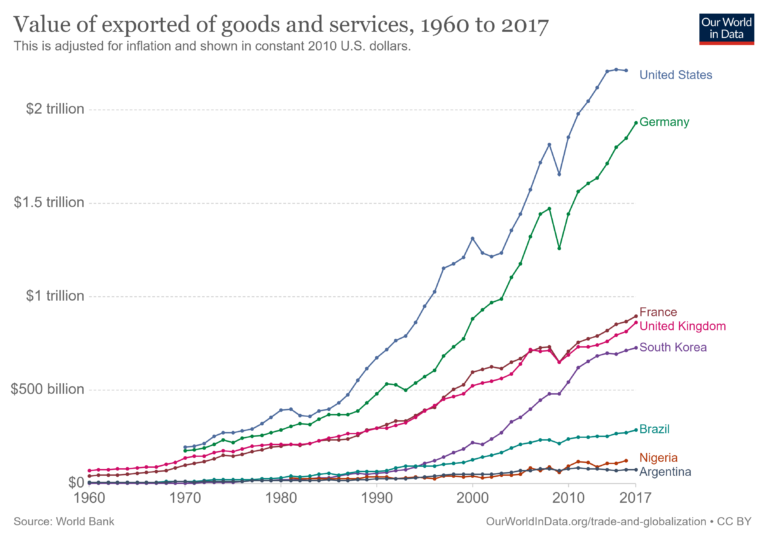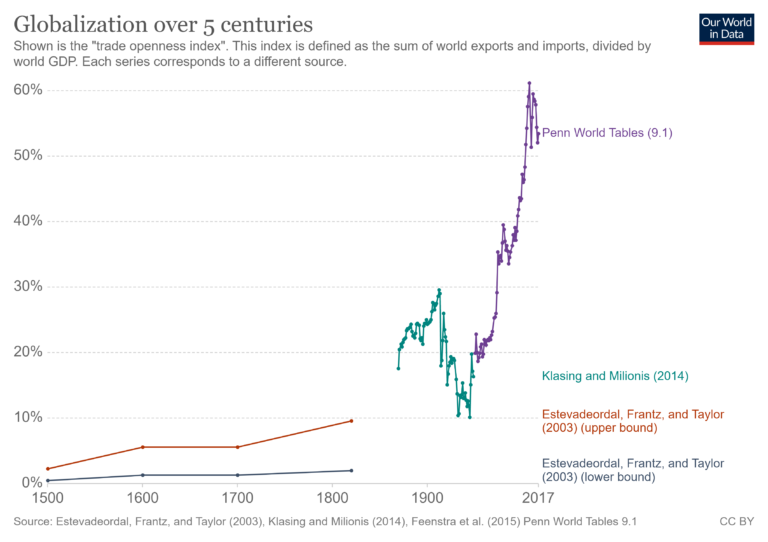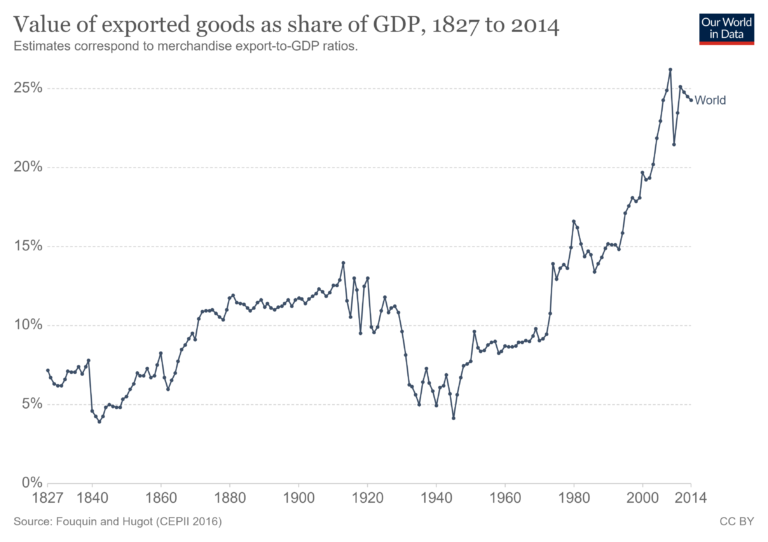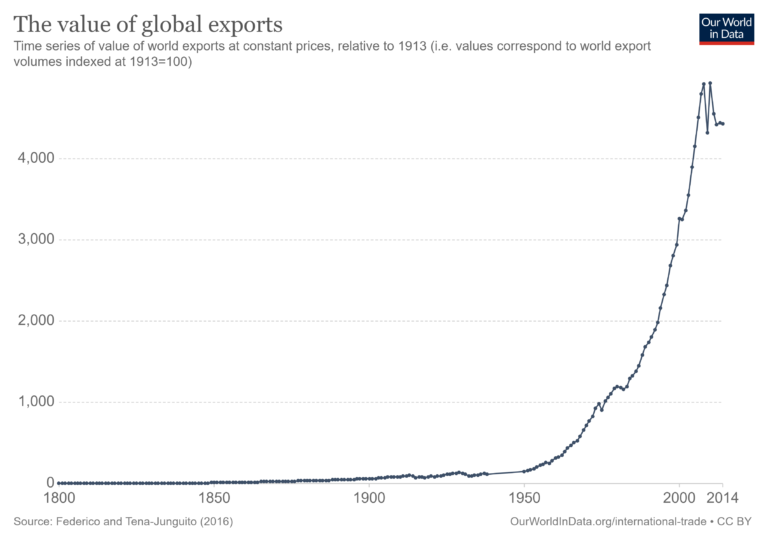Globalization and Deglobalization
Introduction
Globalization is the movement and exchange of people, technologies, and cultural practices across the globe. It is not just the sharing of ideas and concepts between different cultures, but it means the coming together of the entire world without borders to exchange goods and services. Further, it leads to the development and advancement of lower-income countries and facilitates a transfer of knowledge.
On the other hand, Deglobalization is the reduction of integration of nations between each other. It is signified by the decline in cross-border trade between countries. Non-Tariff Bans (NTBs) can cause Deglobalization between nations. Import bans and travel restrictions consequently mean less foreign immigration. This subsequently results in more job security for the local population and more stable prices overall.
According to a report on Globalization and Deglobalization, both phenomena exist in a constant cycle. There can be many reasons for a nation to experience Deglobalization. Certain factors such as trade tensions, diminishing marginal returns of Globalization are just some of the reasons that may result in Deglobalization. The trend of Deglobalization can be observed based on behavioral studies in foreign investments, capital flows, etc.
Globalization And Deglobalization And Their Effect On The
Efficiency Of Global Trade
Globalization has a huge net effect on the efficiency of global trade. It has a significant bearing on capital flows, investment, the exchange of ideas, and the spread of technology to different nations. Overall, Globalization has been found to make markets more efficient over time.

Global trade can be identified by the ratio of world exports divided by world GDP. This provides a reasonably accurate indicator of economic integration and Globalization. When it comes to the effects of Globalization on national trade, the impact is largely positive. The reason is that Globalization helps generate systems to track and trace international trade.
Not only this, but Globalization helps production become more efficient over time. To add to this, it helps improve the working conditions of employees around the world. It also allows companies to maintain their market advantage over their competition. Outsourcing products to lower-cost countries and selling them to higher-income countries helps companies maintain profit margins and stay afloat in the world economy. On the whole, Globalization has a positive effect on increasing competition between nations, limiting cross-border aggression, and distributing wealth around the world.
According to the United Nations, “Globalization has helped to increase economic interdependence and contributed towards the increase in GDP around the world. It allows goods and services to become more affordable by producing them in countries with lower costs of production. To add to this, it also generates millions of jobs worldwide in developing countries. Taking everything into consideration, Globalization has helped to reduce the wage gap between genders and has provided more opportunities for women overall.
Impact Of Globalization And Deglobalization On Capital Flows Between Nations
Globalization brings new opportunities but also fresh challenges to companies all around the globe. It allows companies in developing countries to compete on a world stage with bigger, more established companies. It has provided the opportunity for entrepreneurs in developing nations to change the landscape of the job market in their economy by generating jobs on a large scale.
According to a recent report, migration has been non-uniform among nations around the world, with some countries experiencing higher levels of Globalization than others. Countries like China have been able to grow their economies due to high volumes of exports to other developed nations around the world. At the same time, countries like India have been able to successfully grow their job markets because of job imports from more developed countries.
Owing to this, both Globalization and Deglobalization can have lasting effects on the economies that experience both phenomena. On the whole, Globalization leads to markets becoming more efficient over time while Deglobalization allows countries to stabilize their currency value and capital flows. It also protects a nation’s local jobs and contributes to safety during times of public health concerns like during the current COVID-19 pandemic.
Theories, Facts And Statistics That Support Globalization and Deglobalization
There are some downsides to Globalization that are important to keep in mind. Firstly, it can cause job insecurity in developed countries because of the availability of lower-cost labor from lower-income countries. Not only this, but it can also lead to rising in local real estate prices and changes in currency values. There are two noteworthy facets to Globalization, firstly the nations that implement policies to allow mass migration and the act of opening borders, and the creation of programs to allow qualified immigrants into the country.

Globalization is the increased integration of countries that leads to integration and is a step towards a more interconnected world economy. It has significantly helped countries like China with the exports of large amounts of goods and services to the rest of the world. Developed countries have been able to benefit from Globalization with the ability of lower-cost labor and cheaper import products.

The first wave of Globalization was experienced at the start of the 1900s and ended with the beginning of the First World War. The first observed period of Deglobalization was after the Great Depression and the First World War, from 1929 to 1979. Following this, the world has been in a significant Globalization trend ever since the Second World War ended. Ever since the end of the War, the world has bounced back into a more interconnected and integrated society as a whole.
According to the World Economic Forum, it is more likely that we see an accelerating trend of Deglobalization due to the COVID-19 pandemic.
Conclusion
Overall, it is clear that both Globalization and Deglobalization have their place in the world economy. Since the global financial crisis of 2008, the trend of Deglobalization had begun to gather speed. With the current COVID-19 pandemic, countries are finding ways to keep the economy running even without the benefits of Globalization.

Through constant economic cycles, one thing is clear – Globalization and Deglobalization are interconnected and do not exist without each other. Rather, they are the result of constant changes in economic policy and other prevailing world conditions. Periods of negativity like war and pandemics have symbolically catalyzed periods of Deglobalization, while times of health and prosperity have fueled Globalization across nations.
